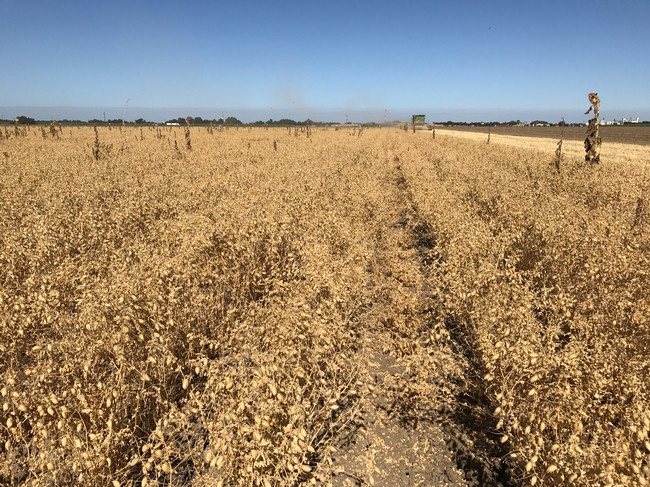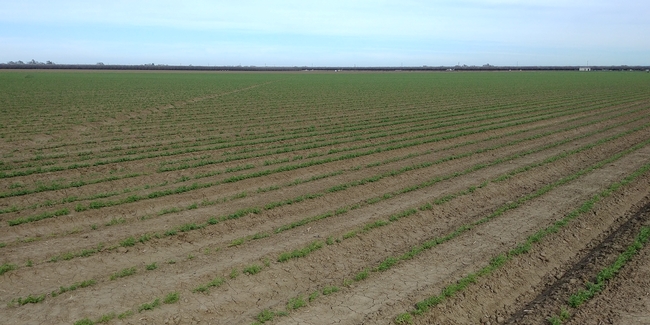
Posts Tagged: garbanzo beans
UC estimates costs and returns for growing garbanzo beans
The UC Agriculture and Natural Resources' Agricultural Issues Center has released two new studies on the estimated costs and returns of producing garbanzo beans, also known as chick peas, in the Sacramento and San Joaquin Valleys.
“Although acreage is relatively small, garbanzos are an important crop because California growers produce the large, cream-colored seed that's used for the canning industry, often used for garnishes for salads,” said Rachael Long, UC Cooperative Extension farm advisor serving Sacramento, Solano and Yolo counties.
The studies estimate the cost of producing garbanzo beans on 200 acres as part of a row crop rotation, using subsurface drip irrigation. A three-row bed tillage implement shallowly chisels, tills and reshapes the beds, avoiding disturbance of the buried drip tape left in place. Planting of seed treated for fungal and seedling diseases, Ascochyta rabiei, Rhizoctonia and Pythium, into residual soil moisture occurs in December. Seeding rates for the garbanzo beans are 85 pounds per acre.
Input and reviews were provided by UC ANR Cooperative Extension farm advisors and other agricultural associates. Assumptions used to identify current costs for the garbanzo bean crop, material inputs, cash and non-cash overhead. A ranging analysis table shows profits over a range of prices and yields. Other tables show the monthly cash costs, the costs and returns per acre, hourly equipment costs, and the whole farm annual equipment, investment and business overhead costs.
“The importance of these studies right now is that they are currently being used to help secure USDA crop insurance for garbanzo production, expected in 2020,” Long said.
The new studies are titled “Sample Costs to Produce Garbanzo Beans (Chick Peas), in the Sacramento and Northern San Joaquin Valleys – 2018” and “Sample Costs to Produce Garbanzo Beans (Chick Peas), in the Southern San Joaquin Valley – 2018.”
Both studies can be downloaded from the UC Davis Department of Agricultural and Resource Economics website at http://coststudies.ucdavis.edu. Sample cost of production studies for many other commodities are also available at the website.
For additional information or an explanation of the calculations used in the studies, contact the Agricultural Issues Center at (530) 752-4651 or the local UCCE Farm Advisors; Sarah Light, selight@ucanr.edu, Rachael Long, rflong@ucanr.edu, Michelle Leinfelder-Miles, mmleinfeldermiles@ucanr.edu, or Nicholas E. Clark, neclark@ucanr.edu.
Garbanzos touted as low-cost protein source
The Fresno Bee's ag savvy food writer, John Obra, wrote an article for today's Life section on fresh garbanzos, with information gleaned at a recent UC Cooperative Extension garbanzo bean field day at the UC West Side Research and Extension Center.
High-protein garbanzo beans, also known as chick peas, are most familiar to consumers as dried bagged beans or cooked canned beans. Obra says the green fresh beans will be harvested during the next few weeks and make their way into the produce section of grocery stores.
The article said young, fresh garbanzo beans are so highly sought after, they can be a poacher's quarry. At the field day, UC Davis Cooperative Extension specialist Steve Temple told stories of garbanzo farmers camping on their fields to prevent thieves from ripping up garbanzo plants for prized young, green legumes, Obra wrote.
In addition to offering recipes for using garbanzo beans, Obra's story noted that the legume adds nitrogen back to the soil as it grows.
These and other winter legumes "will definitely have a role 10 to 20 years from now in California agriculture because of low water requirements and nitrogen fixation," Temple was quoted.


